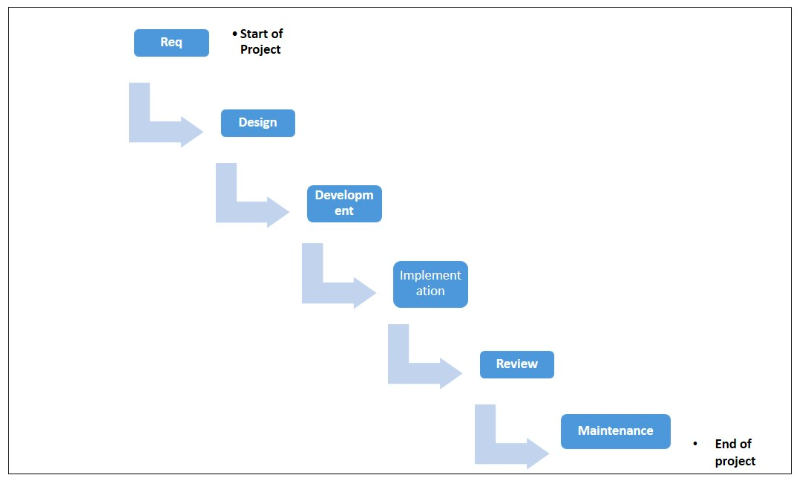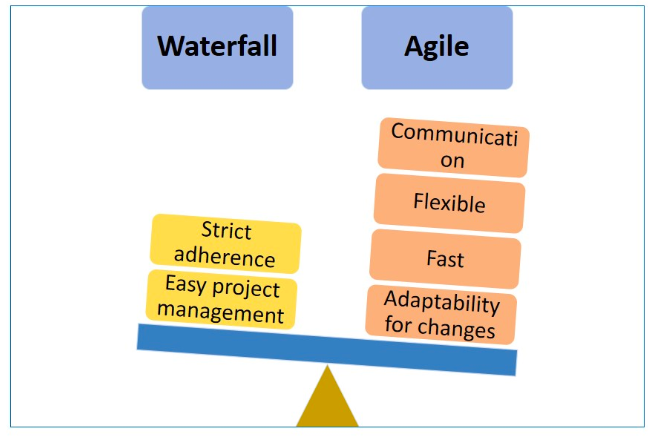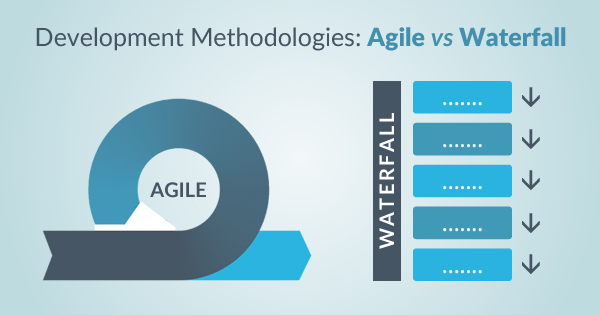Are you in your mid-career as a senior associate or project manager in software development? Then you must have faced the most hurdle step of decision making which is nothing but how to choose an approach for the development? And here comes the big debate over selecting among the two software development approaches agile vs waterfall. Though agile has made a storm over the decade, which development method should win over the game – agile vs waterfall that depends very much on many factors.
We all know that mass adoption of the agile process is a common scenario in enterprises nowadays but a proper evaluation for Agile vs Waterfall should be done before making the final decision considering their pros and cons. Moreover, organizations find the best results when they proceed for the transition to a hybrid agile approach which is nothing but the combination of agile and waterfall and commonly known as agile waterfall hybrid.
So, if you are interested to uncover agile vs waterfall factors then you are in the right place. In this blog, we have discussed over few factors on agile vs waterfall which may help you to understand the fundamental differences between Agile Software Development vs Waterfall Software Development and also differences between agile vs waterfall project management.
Agile Software Development vs Waterfall Software Development – Basics
Agile software development and waterfall software development are software development approaches. But to differentiate both of these, it is important to learn the basic concepts of these approaches first. So, let’s understand first what is waterfall software development approach and what is an agile software development approach.
What is Waterfall Software Development Approach?
Waterfall development follows a sequential process where the entire project is broken into different stages and executed sequentially to complete the project. Here each stage is dependent on its previous stage. Hence, it is like a steady downward flow as the name suggests “waterfall.”
Waterfall approach consists of eight consecutive steps.
- Conception
- Initiation.
- Analysis
- Design.
- Construction.
- Testing
- Implementation.
- Maintenance.
From a software development point of view the above eight steps are combined in a linear sequential life cycle model and follow the below stages:

What is Agile Development Approach?
Agile development follows iterative methods where the project is divided into small chunks of deliverables which are called sprints. Unlike the waterfall model, it is a continuous development approach where planning, development, testing, integration goes hand in hand. This is a better approach for development as it gives better risk evaluation and control over the project and reduces the chances of complete project failure. Interestingly each sprint of agile can adapt the steps of the waterfall model as mentioned above.
Agile sprints always pace up with requirements. Once a sprint is completed, it is reviewed and based on that, decisions are taken which can be used to update the existing requirements. Furthermore, this updated information can be used for the next iteration.
Preparing for an agile interview? Go through these top 25 Agile Interview Questions and get ready to ace the interview.
Agile vs Waterfall Comparison Table
Agile vs waterfall development follow different strategies. We can compare the two project processes based on several parameters. Let’s have a look in below Agile vs waterfall comparison table–
|
Parameter |
Agile |
Waterfall |
|
Quality |
Agile is a continuous and iterative development approach. Thus it provides the scope of iterative testing throughout the process which helps to improve the deliverables throughout the process and ensures quality. Backed by open communication between the teams and clients it assures quality deliverables. |
In Waterfall development testing is an entirely separate phase after development and all the testing like unit testing, functional, non-functional, integration, and system testing happen sequentially and takes place near the end of the project life cycle. Thus fixing bugs sometimes become an overhead for the development team. |
|
Communication |
Agile manifesto principles stress over face to face communication rather than documentation. Thus agile gives quick turnaround time for resolving any issue than the waterfall process. However, communication should be effective rather than aimless. It should be aligned with the teamwork. |
Waterfall method highly dependent on documentation and charts like Gantt charts. This is very helpful in case of government projects which are strictly regulated. As the waterfall method follows a rigorous documentation process if the existing team discontinues for some reasons, the new team can take over the remaining task easily. |
|
Flexibility |
Agile is so popular, and one of the main reasons behind it is its flexibility. The iterative delivery model of agile allows both the project team and customers to foreseeing the shape of the product gradually before it is finalized. Furthermore, the flexible nature of agile considerably prevents scope creep. An agile project is a contract with the flexibility of modifications. |
The steps of the waterfall depend sequentially on each other. If one step is not finished successfully, you cannot start the next step. Moreover, if anything goes wrong at any step post-execution, you need to reiterate all the previous steps. This enhances the possibility of scope creep. Besides, in the waterfall, a contract is inflexible as the project team, and stakeholders agree upon the final product beforehand. Thus any significant change or introducing new requirement in the project is a hiccup for project management. |
|
Customer Satisfaction |
Customer involvement is a critical criterion in an agile project. As a result, they can actively participate in development. From a developer’s perspective, it is an advantage as they can get clarification promptly due to the onsite availability of the customers. Whereas, it gives cost benefit from a project management perspective as any additional requirement from client end during development will cost the client. |
Waterfall model is advantageous for clients. As the entire contract is signed off at the upfront, any change during the project it is an overhead for the project management because the client expects to get the final product within budget and on time. |
Agile vs Waterfall – Which One has More Advantages?
Agile vs waterfall has its own flavors in terms of advantages.

Advantages of Waterfall Development
- A waterfall is sequential hence it is a well-structured process.
- As work for each step of the waterfall process is predefined and agreed, so it is consistent and easy to manage.
- It follows a simple and conventional development model.
- Requirements are clear and predefined and less likely to change during development. Hence, it is easier for a development team to continue their work based on the design.
- The project timeline is usually more extended, and each team gets enough time to finish their tasks.
- Waterfall model follows a linear pattern. Hence, project implementation is straightforward.
- Waterfall model does not require many resources to execute the project.
- Waterfall model maintains proper documentation. Thus anybody can take charges easily even in the mid of the project.
- In Waterfall model project team size, cost and timeline are predefined.
- This approach is ideal for government regulatory projects.
Also Read: Top Agile Certifications in 2019
Advantages of Agile Development
Agile means “moving quickly” indicating the dynamic approach of Agile.
- Agile is a dynamic approach
- Agile is a flexible
- Agile is very adaptive to changes.
- Agile approach synchronizes with ever-changing requirements.
- Agile delivers rapidly which helps to satisfy customers.
- Onsite availability of customers eliminates guesswork in case of issue.
- Face to face communication among the teams and clients ease the process
- It is collaborative.
- Agile gives the scope of continuous improvements due to prompt and frequent reviews.
- Agile gives the scope to include new requirements and accepting change requirements during the process.
- Testing for an agile process is more rigorous and also opens up scope for automated testing.
- The progress of the project is easily measurable in this Agile by the amount of completed work.
- Due to the continuous improvement process, agile process meets the clients’ expectation at a higher rate.
- Sprints in the agile process are executed based on priorities set by the clients. Thus clients can quickly evaluate and provide their feedback about the development status and product.
- Bugs are resolved In Agile in each sprint, so there are very fewer chances that you face any error at the end of the development cycle.
- Agile encourages self-motivated team and cross-functionality.
- Quality control is also easier in an agile process.
- Using backlogs, progress monitoring is also easy in this process.
- Agile helps to save time and reduces waste of workforce by less documentation process.
Note: Though in Agile vs Waterfall race agile is ahead in the game, but getting the true essence of agile in reality is a challenging task. Thus in most of the cases, agile waterfall hybrid model is used in reality.
When to Use the Waterfall Model and When the Agile?
In one sentence it depends on the project requirements, size, and capability of the team. Besides, waterfall vs agile factors is not the best answer for this. However, here are some of the common scenarios that tell you when to use the waterfall model and when you should go for agile.
Waterfall
- If the project and client have a clear vision of the final product.
- When fast turn-around is not required.
- When the project is a large project.
- Government projects which maintain strict regulations.
Agile
- When there is a need for rapid delivery.
- If the clients have the ability to change the scope of the project in between.
- When there isn’t a clear picture regarding the final product.
- When you have skilled developers, who are adaptable and able to think independently.
- If the product has the possibility to change the standards frequently.
Waterfall and Agile Project Management – A Comparison
Iteratively, managing detailed work is much effective than managing it for the long term. Thus effectiveness in agile project management is higher than traditional waterfall project management. One of the main reasons behind it is the sprints in agile development as it brings a rhythm in the whole process. Additionally, project managers often fail to prevent the chances of scope creep in the waterfall method due to less flexibility and involvement from clients.
On the contrary, as agile project management allows stakeholders, product owners, and the development team to communicate openly, assessing the progress of the project along with risk analysis to become easier. This also helps in budgeting and scheduling the project more accurately.
However, the efficiency of the project manager in an agile project matters a lot if you consider the waterfall vs agile point of view. The project manager in an agile project works as a middleman between the developers and customers. Thus making open communication effective between the two parties, the project manager must play a key role. Additionally, the project manager must keep an eye on the project length and make sure that it should not consist of a large series of sprints and within budget.
An efficient team is a must for an agile project, and the project manager must be ready to handle the unpredictable nature of the project as agile does not define the final product during the planning stage. Though frequent communication makes the process more manageable, it has an inherent possibility to bring up complaints and pressure from clients due to frequent reviews. No such overheads are there in waterfall project management.
Hence, overall if you compare the complexity between waterfall and agile project management, then a waterfall project is much easier to manage than an agile project. As it strictly follows deadlines and budget, so total planning of a waterfall project happens at the upfront which makes a waterfall project management much structured than the agile one.
A Negotiation between Agile and Waterfall – Agile-Waterfall Hybrid
Though agile is an excellent development process in the ever-changing business world but making a project truly agile is a real challenge. And the final answer for the agile vs waterfall is agile waterfall hybrid which is the combination of the best of waterfall and agile. The result of the long debate on agile vs waterfall gathers the key features of both the methods and concludes in agile waterfall hybrid. Some of these are:
- The agile-waterfall hybrid approach follows the agile approach where the entire task is broken into several stories based on the planning and requirement and then prioritize them as per the client need.
- Though the overall process follows an agile approach, however, the hardware aspects of the project can be followed using the traditional waterfall method.
- This model increases the speed of project execution maintaining the quality of the product but decreases the cost.
- The agile waterfall development model follows agile principles.
- The agile waterfall hybrid approach is ideal when the requirements frequently change within a limited timeframe.
- To make this model a success both the agile and waterfall team must collaborate properly. Otherwise, the emergence of the two processes at the later stage can create a problem in the project.
To know more on agile waterfall hybrid, please refer to our previous blog on Hybrid Agile used in Various Industries.
Final words
Agile vs waterfall is a continuous debate, but the ultimate goal is to deliver a stable and maintainable product which can meet the goal of customers and business. Thus, certification in agile project management matters a lot that proves one’s expertise in the domain. If you are an agile practitioner, validate your skills now with the PMI Agile Certified Practitioner certification. Join our PMI-ACP training course and PMI-ACP Practice Exam and get yourself ready for a bright career.
If you still have any doubt about Agile and Waterfall development approaches, just write in the comment section below. We’ll revert in no time to resolve your query.
- Top 10 Highest Paying Cloud Certifications in 2024 - March 1, 2023
- 12 AWS Certifications – Which One Should I Choose? - February 22, 2023
- 11 Kubernetes Security Best Practices you should follow in 2024 - May 30, 2022
- How to run Kubernetes on AWS – A detailed Guide! - May 30, 2022
- Free questions on CompTIA Network+ (N10-008) Certification Exam - April 13, 2022
- 30 Free Questions on Microsoft Azure AI Fundamentals (AI-900) - March 25, 2022
- How to Integrate Jenkins with GitHub? - March 22, 2022
- How to Create CI/CD Pipeline Inside Jenkins ? - March 22, 2022




Hello Dharmalingam,
That’s a great post.
You have cleared our doubts regarding agile and waterfall software development.
It will be used to the people who want to develop software for the customers. with the help of this post, we can achieve success.
Thank you, Mr.Dharmalingam
A simple yet efficient guide on the subject, thanks a lot for the details.
very help full blog, for sharing content and such nice information for me. I hope you will share some more content about. Please keep sharing!
Like!! Great article post.Really thank you! Really Cool.